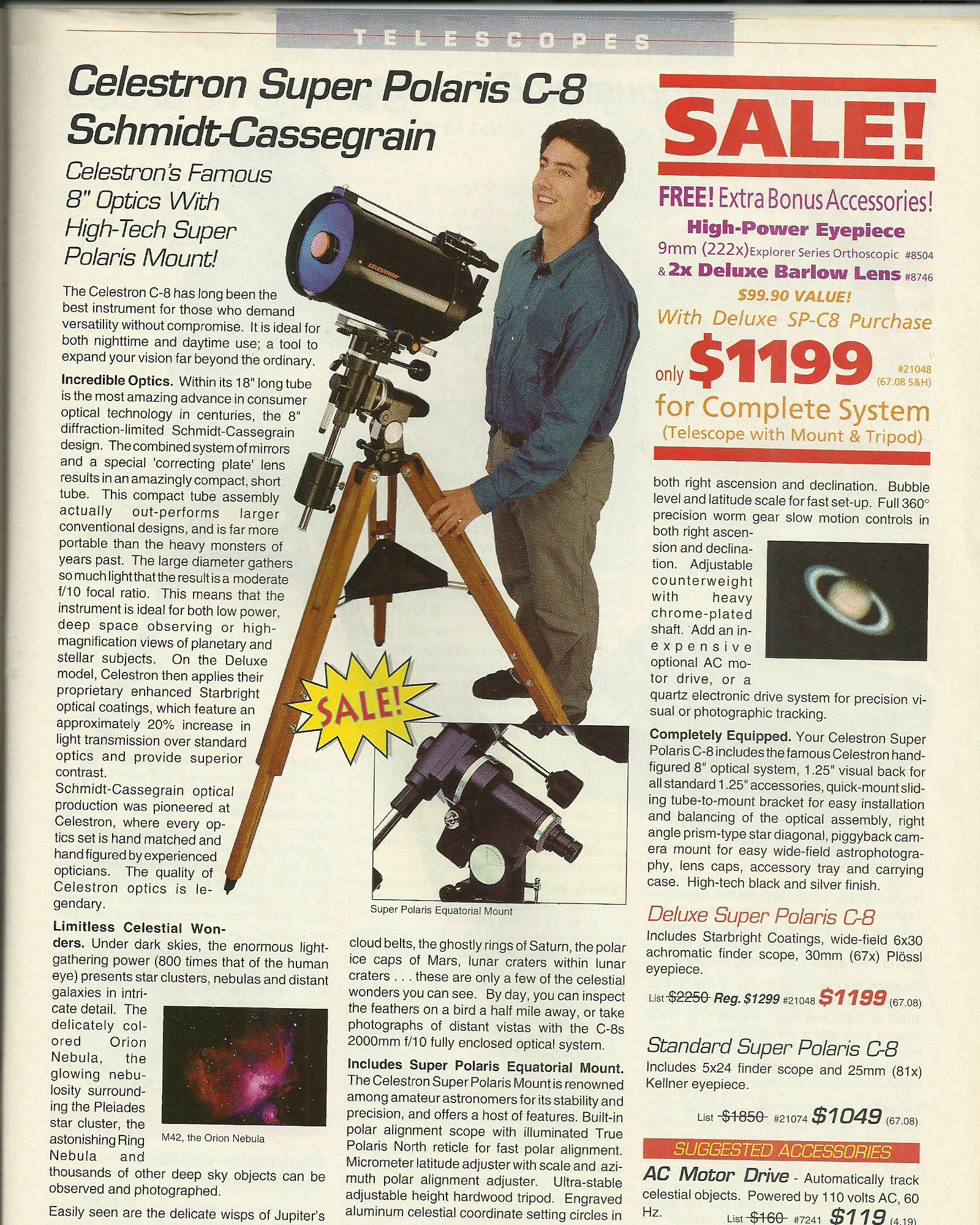
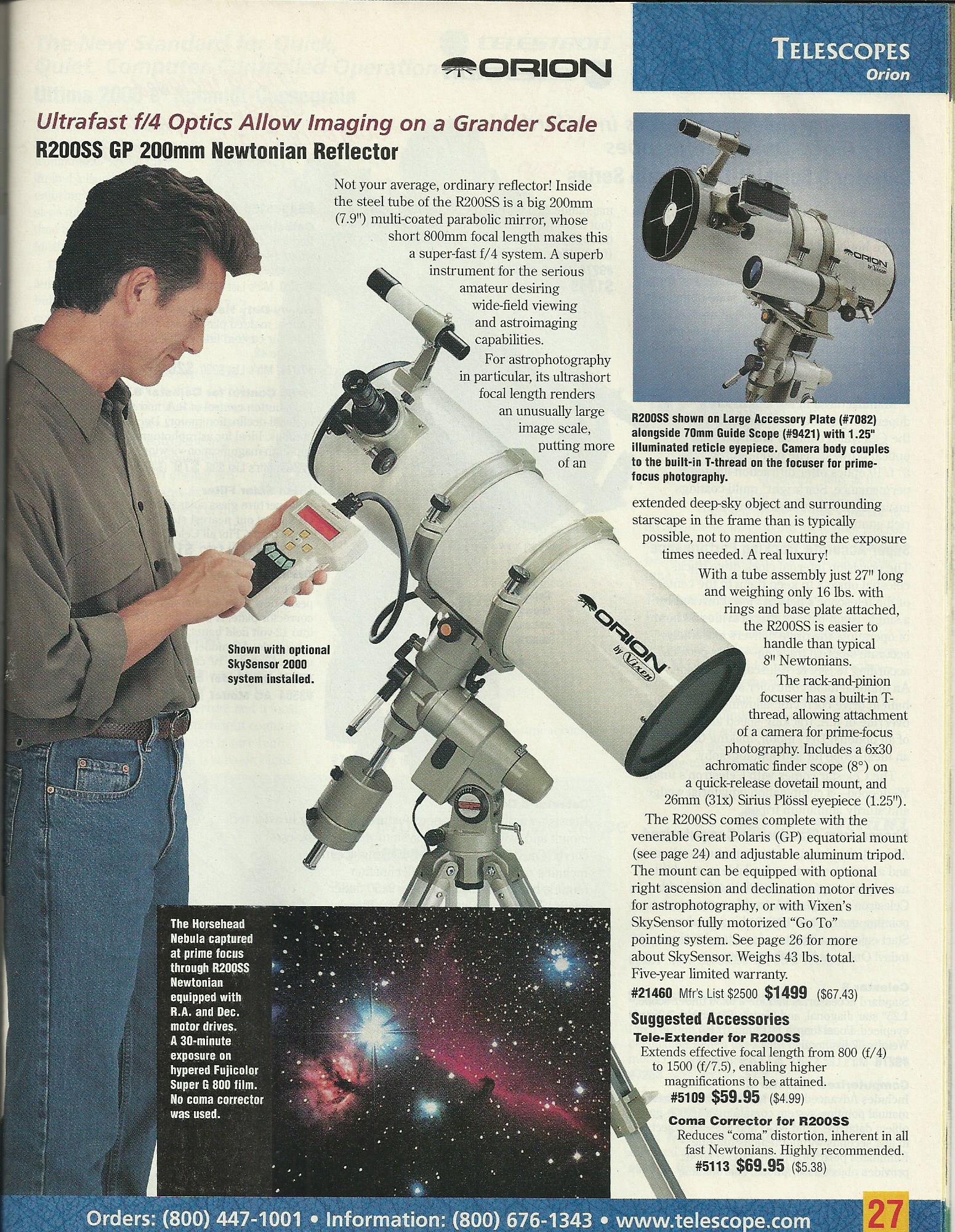
A Brief Survey of Celestron Equatorial Mounts
By Ed TingUpdated 3/11/2018, 3/22/18
In the Beginning...
Although it's second nature to us now, until the late 1980s or so, the idea of swapping optical tubes and mounts was largely foreign to amateur astronomers. Own a Meade optical tube? Back then, chances are it lived on a Meade mount its entire life, and you never gave any thought otherwise. You didn't swap out a C8 onto a Meade fork mount, or vice versa. Credit Vixen's Polaris series of equatorial mounts for changing all that. The series started out with the Polaris mount (non-extendable legs) and the Super Polaris (similar but with extendable legs.) Later on, the family grew to the Great Polaris, and then the larger Great Polaris DX.
I remember those mounts fondly, and likely so do you, if you were in the hobby in the late 1980s through the late 1990s. It's not a coincidence that around this time, manufacturers started selling OTAs by themselves, leaving the choice of mounts up to the user. Look at the early reviews on this site and you'll see the Super Polaris all over the place, primarily holding small refractors. The introduction of the P/SP/GP/etc mounts were a boon to astrophotographers who needed better, more precise tracking (the inclusion of the polar scope helped; overnight, we began to wonder how we ever lived without them.) The burgeoning digital imaging revolution was just around the corner.
The Polaris mount, with its fixed wooden leg height, was sold with 4.5" - 6" Newtonians and other small scopes. The Super Polaris, with its slightly beefed up equatorial head and extendable wooden legs, was more versatile, and for several years had the mid-sized equatorial mount market locked up by itself. I recall many, many late nights with this mount, holding my beloved Takahashi FS102. It also held C5s and C8s. The Great Polaris was an outgrowth of the Super Polaris, but some felt the aluminum box-section legs were a step backwards. Finally, the GP-DX was a larger version of the Great Polaris. There was also, briefly, a Super Polaris DX (unseen by me.)


(Above: From Orion's Fall 1992 and Fall 1997 catalogs)
Vixen partnered with Celestron, and then with Orion in the late 1990s. Prices were high compared to what we are used to today. I remember Celestron would sell their 4" f/8.8 achromat on a Super Polaris mount for a cool $1499. In the late 1990s, the GP was paired with many OTAs, including Russian Maks, and Vixen's own 8" f/4 Newtonian, and their unique VX120 Petzval. Motor drives were almost always optional, and standardized Goto was just around the corner.
You could feel standardization coming around the corner. You could smell it. But then, for whatever reasons, it never really came together for Vixen. In the early 2000s, while the GP/GP-DX were still available, you began to see fewer of them out in the observing fields. Very cheap clone mounts from China were taking over, and while most of the initial units were not very good (back then a friend once told me to "buy two" when ordering) the prices were low enough to entice amateur astronomers to give them a try. I recall attending Astrofest in IL in 1998 or 1999 and seeing an importer trying to make a go of selling these mounts. One model held what looked like the spitting image of Vixen's 8" f/4 Newt on a GP, for less than $300. Be still, my heart! But when I got closer, I noticed questionable workmanship and rough motions on the axes, and the optical tube looked hastily put together. Still, I almost bought it (at the time, the real thing sold for over $1500.)
You know what happened next. The Chinese raised their game, forcing competitors to join them in sourcing their products overseas. Those that didn't often found themselves in tough shape.
The Plate
It's strange to think that the legacy of the Great Polaris lives on in...a plate. Today we talk about Vixen dovetail plates, but many of these "Vixen plates" out there are technically Vixen-style plates. Whatever you call them, the Vixen plates have become a standard in the industry. Almost all small to mid-sized telescopes either come with them already installed, or have provisions for them. The Super Polaris had its own plate, but it was incompatible with the GP's Vixen plate (despite looking similar.) I still have my TeleVue-SP plate. I hang onto it, waiting for the moment when I might need it again. C8s from around the 2000 era sometimes came with SP plates molded into the visual back (anachronisms today.)
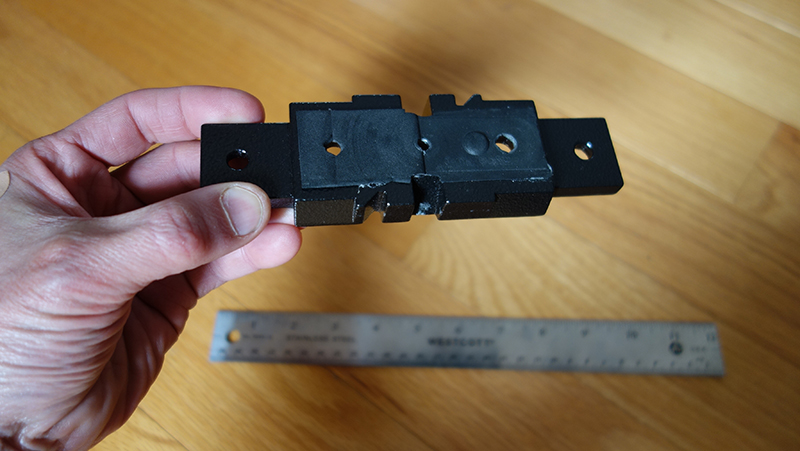
Enter the CG-5 (~$500-$600, NLA)
An entire generation of amateur astronomers grew up with these mounts. Debuting around the year 2000, these mid-sized mounts were larger and heavier than the Super Polaris and reasonably priced. Early versions were non-Goto, and some very early versions were rough by today's standards. My first CG-5 had exposed motor housings, complete with a fragile circuit board with its jack sticking out, waiting to be snapped off. You had to be so careful not to set the mount down on the wrong side or the little board would break (which mine eventually did, turning my CG-5 into a manual mount.) Later versions used a protective cover over the motor and circuit board, making it much more difficult to break. If you're in the market for a used CG-5, this is the earliest model that I would recommend getting.
The same platform used to build the CG-5/AVX was/is used by other manufacturers. These include the Orion Sky View Pro series, Meade's LXD55/75, Bresser's EXOS series, Skywatcher's EQ3, and others (forgive me if I have left out your favorite.)
The CG-5 really came into its own when they began to be offered with the Goto system. The new mounts are technically called ASGT (Advanced Systems Goto) but most people still refer to these mounts simply as the "CG-5." The new mounts were reasonably priced (around $600) generally reliable, and they did a lot. There's a lifetime supply of objects programmed into the hand controller. It also came with a decent autoguiding port. For the first time, equatorial mounts were giving fork-mounted Goto systems a run for their money, technology-wise. The ASGT CG-5s were paired with a bewildering variety of optical tubes, often at prices so attractive that hobbyists were sometimes seen buying OTA/mount combinations and then selling off the scopes. It uses the same #94224 polar scope (about $45) as the AVX and the CGEM.
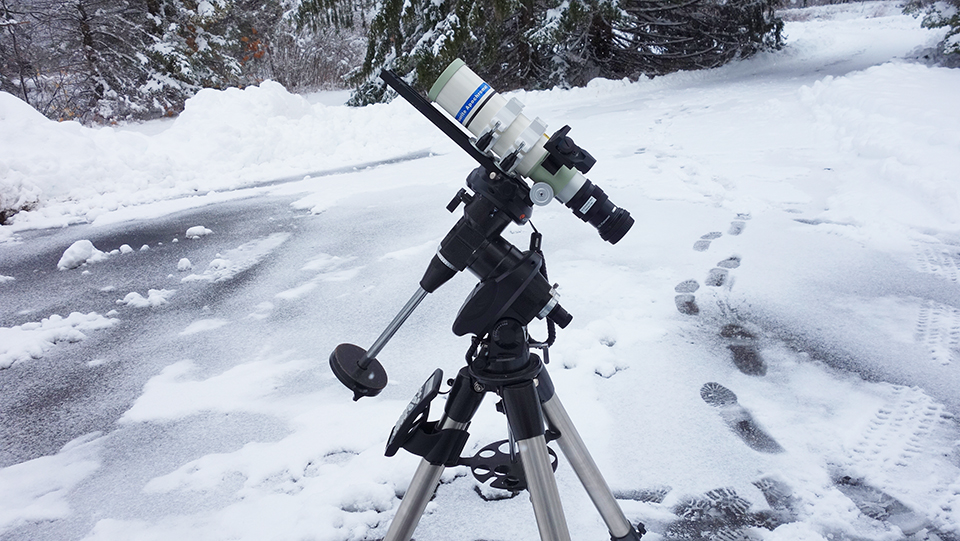
(Above) CG-5 (Scope: Takahashi FS60)
It is a long-standing tradition that manufacturers inflate their mount's payload capacities, and the CG-5 was no exception. Depending on where you looked, you would see weight claims of 30-35 lbs for the CG-5. Yikes. Putting 35 lbs on a CG-5 goes well beyond cruel and unusual punishment. I've stated this personal rule of thumb before, but I think once you need more than one of the supplied counterweights for any equatorial mount, you are asking for trouble (this is just a rule of thumb, and if you look around this site, I do violate it from time to time.) Most CG-5s were supplied with counterweights of about 11 lbs. In real-world terms, that equates to a 6" - 8" SCT, a 4" refractor, or perhaps one of the shorter, lighter 6" Newtonians. That's it, in my book. I would not put a C9.25, or one of the Meade 10" SCT OTAs on this mount. A 5" apo will give the mount problems, not only because of its weight, but because of its length. You're going to find some disagreements on this matter, but I think 12-13 lbs is about the practical limit for a CG-5. That didn't stop sellers and resellers from putting more weight on these mounts. I recall one Celestron catalog where they sold C11 OTAs on the CG-5 (there were three counterweights on the shaft.) My heart aches for that poor CG-5 just thinking about that.
With the leap into the brave new world of technology came problems. Most CG-5 owners experienced trouble free service, but if something did happen to you, it could be frustrating. Controllers would freeze up, and sometimes the mount would start doing crazy things. Seeing "Transmitting Data" on your frozen hand controller for the first time is a scary experience. Look at the online forums and you'll read about all kinds of odd behavior. I've owned three CG-5 Goto mounts, and at some point or another all of them did at least one strange thing to me. Most of the time, cycling power, reseating the cables, spraying the jacks with cleaner (DeOxit seems to be a popular choice) doing a factory reset, or updating the hand controller cleared the fault. Even when the mounts run well, I find about once a year I need to do a factory reset to keep the gremlins at bay.
If you update the controller, keep in mind it has to be plugged into the mount and your computer at the same time, and the mount needs to be powered up. Also, at least on my setup, you need an RS232-to-USB adapter cable if your computer does not have one of the older RS-232 ports. These Celestron controllers all look similar, but there are many versions. Confusingly, most of them say "NexStar" on them, even if they are not used on NexStar mounts. If you are updating a NexStar controller on an equatorial mount, check to see that it says "EQ" on it somewhere. If it doesn't say "EQ" on it, the controller may be intended for the Alt-Az NexStar mounts (Note: this last bit was told to me by a Celestron rep. Although I have no reason to doubt him, one of my equatorial CG-5 controllers does not have EQ written anywhere on it.) Finally, if your controller seems dead, you can order a replacement (make sure you get the "EQ" version!) for around $150 from various retailers. You can also find "stray" hand controllers for sale on the used market, and at trade shows like NEAF (whenever I get one of these, I reflash/update it as soon as I can.)
The mount's electronic problems could be unpredictable and erratic. One CG-5 I owned developed electronic problems so serious I gave up on it (sending it back to Celestron would have been too expensive; it would have been cheaper just to find another used sample.) Out of exasperation I traded it to my friend Mike for an Orion Short Tube 80 OTA (yes, you read that right, an Orion Short Tube 80.) Almost immediately upon getting it, the mount began working fine for Mike and has worked ever since. Sometimes when I see him with it out in the field he waves at me. "Thanks for the mount, Ed!"
I don't mean to exaggerate the mount's problems, or scare you off. Again, most owners report trouble free service. You should just be aware that all the new fancy features do some at a price. Despite the mount's occasional issues, I still think a clean, used CG-5 ASGT is your best overall buy in a mid-sized equatorial mount. If the mount has been hypertuned, or has an aftermarket plate and/or knobs, it's usually a sign the owner has taken care of it. Prices are more than reasonable these days, and they seem to be falling, as owners flock to the new AVX.
The AVX ($899)
I resisted upgrading to the AVX at first, having invested heavily in three CG-5 ASGT mounts. However, as soon as I played with one at a star party, I knew I wanted one. I kept one CG-5 ASGT as a backup and sold a bunch of other equipment to get one of the new AVXs. The AVX is an upgraded, tweaked CG-5. There is nothing earth-shattering here, but the little upgrades add up and make for a far smoother experience. The hand controller is easier to read, and the up/down buttons are contoured, making them easier to find in the dark. The head is sturdier, and there are now two knobs on the saddle plate, instead of the single knob/safety screw arrangement on the CG-5. Gone is the brittle "speckled Chinese steel" on the CG-5, which could sometimes fatigue and snap off. The counterweight has a flat spot, so it won't roll away if you set it on its edge. The toe-saver bolt on the shaft is better. The power jack has been moved to a fixed point on the back of the mount and no longer moves while the mount is slewing. While it's rated for the same payload capacity as the CG-5, I find I can put slightly more weight on the AVX. Don't go crazy here, we're talking a heavier finder or diagonal, or maybe a big eyepiece. You get a small safety factor compared to the CG-5. So we're still talking something in the 12-13 lb range for a payload.
For imaging, I try to keep the weight below 9 lbs. Keep in mind, in imaging, weight adds up fast. For example, my AT72 telescope only weighs 5.2 lbs. But when I add the camera, autoguider, plates, etc., the total payload tops out just over 9 lbs. The FC76 weighs a little more than the AT72, and while I will use it on the AVX, I expect to have a few badly-guided subframes and budget my time accordingly. The FS102, forget about it. This is the reason you usually see an FS60 on my AVX and CG-5 when I'm imaging.
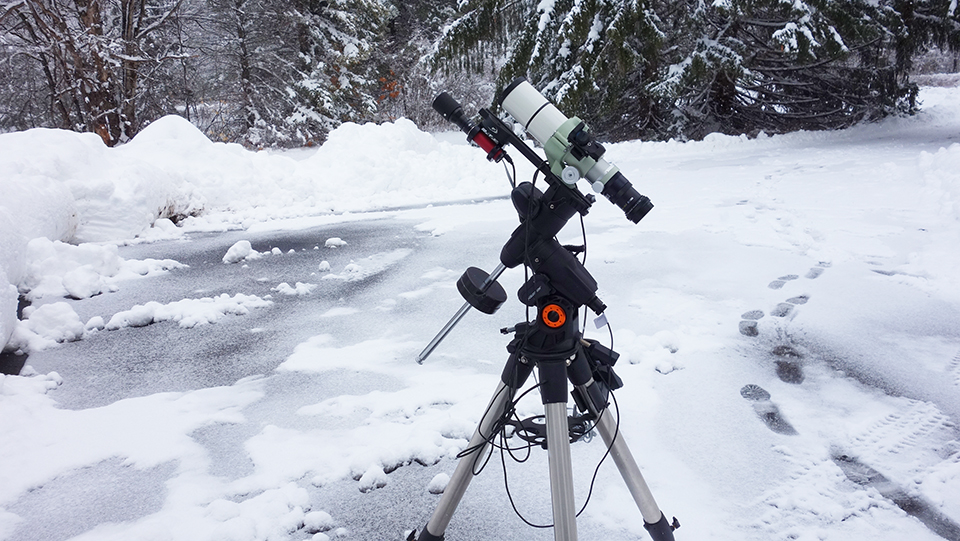

(Above) AVX (Scope: Takahashi FS60)
The real changes are under the hood. At first glance the AVX looks like a CG-5, but the mechanics and electronics have been completely reworked. CG-5 owners will immediately hear that the AVX's motors are much quieter. I find the Goto system more accurate, and if you do imaging, the autoguider port is definitely better. At least one Celestron employee has told me the AVX is his favorite mount - if you don't need the additional weight carrying capacity, it's smoother and more accurate than the CG-5 or the CGEM. You have to go all the way to the new CGX and CGXL to get a more accurate mount. When I'm in a hurry and running out the door, the AVX is the mount I grab without thinking about it. I've used it for countless astrophotos and can report the autoguider port is excellent. It uses the same #94224 polar scope (about $45) as the CG-5 and the CGEM.
As with the CG-5, all is not perfect. My evidence is anecdotal, but I notice a slight increase in electronic problems with the AVX, as opposed to the CG-5 ASGT. Worst of all is the dreaded "Error 16/17" which often requires a trip back to Celestron. The problem with this error code is it will often not allow you access to the main menu to do a factory reset. Your only solution is to reflash the firmware and then hope for the best. There are a couple of club members who have had to send their mount heads back to Celestron; I feel for them. I should point out that my AVX has never had a serious problem, and it gets used a lot (as much as 80-100 times a year.) The only issue I've had is about once a year it starts acting strangely and needs a factory reset. On mine, the factory reset (so far) has cleared the fault. Again, other than that issue mine has been OK, but I have this nagging feeling a big problem is waiting for me around the corner.
You also pay for the upgrades. The AVX started at $799, and has recently gone up to $899 (sales and discounts are common.) Used prices are settling about $100-$200 lower, making them good buys, especially if they have upgraded accessories like ADM plates and hardware. If it isn't obvious, I like this mount a lot and would buy another one with no hesitation if my current AVX died.
The CGEM (~$1499, NLA)
If you're looking to mount a larger scope like a 9.25" - 11" SCT or a big apo, the AVX won't do. You need something heavier. Enter the CGEM. I bought one to hold my 10" Meade SCT. The CGEM is the gateway to the world of the Big Mount. It is largely the same mount at Orion's Atlas, so if you prefer to deal with Orion (or simply prefer blue to orange) you can always head over there. One caution - if you're buying used, early Altas mounts were non-Goto. On the other hand, all CGEMs are Goto. The mount also appears to be the same as the Skywatcher EQ-6 (unseen by me.) The CGEM uses the same #94224 polar scope (about $45) as the AVX and the CG-5.
When you first get your CGEM, it is obvious you're looking at a serious and substantial piece of kit. The head has a massive faceplate; putting it on the tripod is not something you take lightly. The mount is large enough that you should seriously consider putting it on a wheeled dolly, like the JMI units. Having the mount fully assembled and ready to wheel out encourages you to use it. I know of people who own CGEMs who keep them disassembled to save space, and they rarely get used as a result.
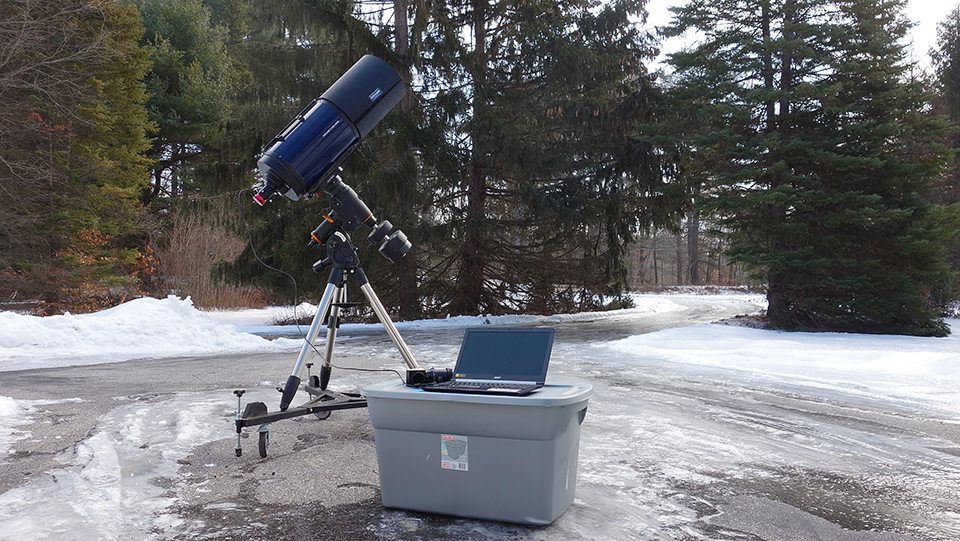
The good news - the CGEM is sturdier than the CG-5/AVX and will hold more weight. If there's any bad news, it's that the mount doesn't hold quite as much as I would have expected, given its weight premium over the AVX. As a general observation, I expected 50% more out of the CGEM. In reality, I think I'm getting something more like 20%. The 10" SCT is a little shaky, and I would not personally put an 11" or 12" SCT on it. Looking at the mount side by side against the AVX gives a clue as to why. The mounts use many of the same parts, including the legs, counterweight and shaft (I'm currently using an AVX counterweight on the CGEM.) Seeing them together, the main difference with the CGEM is its larger, heavier head. So for me, I'm looking at a 5" apo, or a C9.25 as a suitable load. For imaging, I'd be comfortable with an 80-100mm refractor, as long as the latter wasn't too heavy (the CGEM has trouble autoguiding my FS102, which is heavy for a 4" class refractor.) It's a "tweener" mount, partway between the AVX and the Really Big Stuff like the new CGX.
Other issues? The CGEM is closer, generation-wise, to the CG-5 than the AVX, so it isn't quite as accurate as the AVX. My sample seems to have modest hysteresis (I've played with the backlash controls and it didn't help much.) The autoguider port is good, but the one on the AVX is better. Also, the power plug/jack, located on the side of the mount, will sometimes pull out if the scope slews around a lot and you aren't careful with cable management. This is going to be a potential problem for any mount where the jacks are located on a part of the mount that moves. See the similar photo above on the AVX, where the jacks are located on a fixed part of the mount (the new CGX also fixes this problem.)
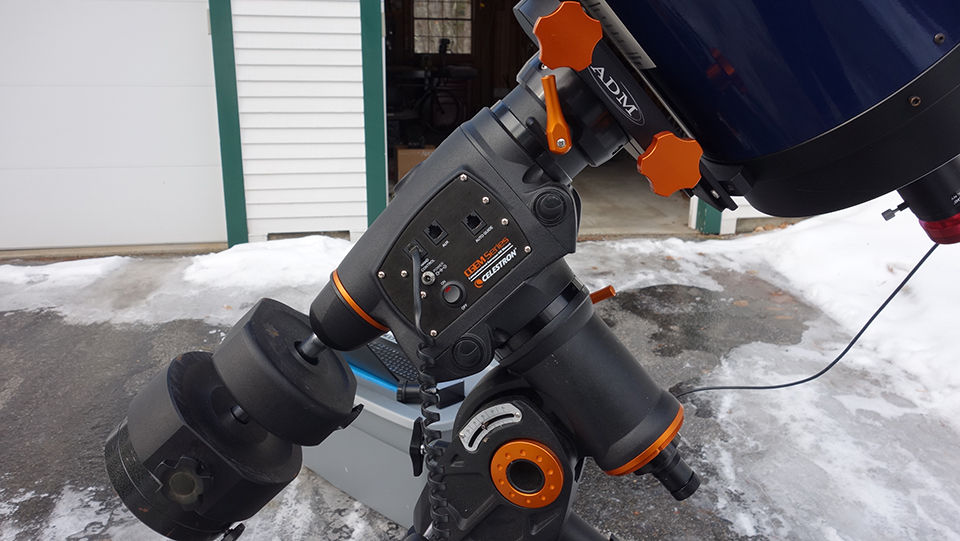
(Above) The unmistakable "flat" faceplate of the CGEM
Am I being too harsh? Maybe. The CGEM is the only mount in this survey that has never given me any electronic problems (it does, however, get used the least.) Still, trouble free electronic service is something to write home about these days and it should be noted. I'm hanging onto it for now, but although there's nothing really wrong with the mount, I expected it to hold more weight. If it did, I would not have had to get the CGE.
The CGEM was replaced by the CGEM II. I haven't seen one of those.
The CGE (~$1999, NLA)
If the CGEM is the gateway to the Big Mount, the CGE is firmly in the category. It's a Big Mount, a candidate for a permanent setup. The CGE uses some parts from Losmandy's G11, but I think it's actually more sturdy than a G11. The G11 is built for a C11. When I had a G11, it would hold my C11 well, but the C14 presented problems. The CGE's previous owner, on the other hand, had his C14 on it and I did not hear of any issues. The electronics are housed in the circular section just below the equatorial head. Other than the hand controller, the mount does not use any parts from any of the other smaller mounts. Unlike the CGEM, you are not going to be putting any of the AVX's puny counterweights on the CGE's shaft. The CGE uses the wider Losmandy-style "D" plate. If you want to use a Vixen-style plate, you can replace the head with an ADM unit which has slots for both plates, or buy Losmandy's VSP jig that sit inside the D-plate slot and has a Vixen slot of its own (I use the latter arrangement.)
Like the other mounts, it does not come with a polar scope. The CGE's polar scope is a different animal. It mounts on a bracket that sits behind the equatorial head. The scope is expensive at around $150, and must be removed after polar alignment because the bracket will get in the way. This arrangement is another hint that the mount should probably be in a permanent observatory. I've transported it a couple of times already, and while it can be done, I can report that hauling this thing around (especially in the cold) is not exactly fun.
I've been doing a lot of imaging lately, a realm in which there is no such thing as an overmounted scope. I often tell people you need a mount three sizes too large for your OTA to properly hold it. As a case in point, my 12 lb FS102 works fine visually on the AVX, but ask an autoguider to hold it steady and the AVX is inadequate. Even the CGEM is inadequate. It wasn't until I got the CGE that I found a mount that would hold the FS102 steady enough to take the 6-7 minute subframes I need to take to capture extended objects.
When I first got the mount, it had been sitting in someone's garage unused for some time. As is my habit when getting used mounts, I set it up indoors, did a fake alignment, and let it run all day. About five hours later, I happened to be walking by the scope/mount and suddenly heard the motors running by themselves (I hadn't pushed any buttons.) I watched as the scope slewed itself into the mount, and then listened in horror at the high-pitched whining of the motors as the mount attempted to keep moving the scope against the stops. I killed the power.
Welcome to the CGE Runaway Motor Problem. It is a shame that such an otherwise fine piece of equipment would find itself saddled with a fatal flaw. Although my sample size is small, every CGE owner I've corresponded with mentions this problem very early in the conversation, and the internet is filled with chatter about this topic. The problem can be traced to the RA/Dec cables, or more specifically, the jacks that these cables plug into. The jacks on the CGE are placed at inconvenient, cramped locations, requiring a sharp bend in the strain relief of the cables to clear the mount housing. I got a replacement set of cables from Scopestuff, which unfortunately have even longer strain reliefs; the cables just barely fit in the space allotted. Owners mention spraying the jacks with DeOxit, but this may be a placebo. The only permanent solution is to get rid of the stock cables and jacks altogether. This fix is commonly known as the "Gary Bennett Mod." The Mod fixes the problem once and for all by using DIN-style connectors (similar to the ones you see on Astro-Physics and Takahashi mounts) and by rerouting the cables out of the side of the mount housing, instead of in the cramped space on the stock mount. The fix is not cheap. Depending on options, you are looking at over $500 to get everything shipped to you, and you still have to perform the mod yourself. I have heard of very few problems with these mounts once the Mod is performed, suggesting the CGE is a solid piece of equipment otherwise.
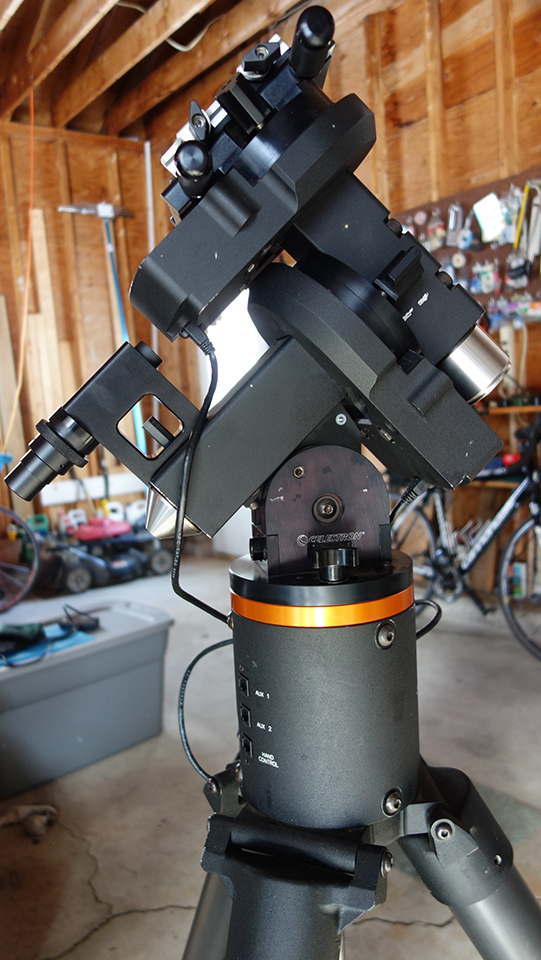
(Above) CGE mount. Note routing of cables on RA and Dec, and dedicated polar scope at left.
I don't have the Gary Bennett mod on my CGE, but I look at his web site a lot and am thinking about it. When/if I get this performed, I'll report back.
The CGE was replaced by the CGE Pro, which I have not seen. Both CGE mounts were recently replaced by the new CGX and CGXL.
The New Generation - The CGX ($2199) and the CGXL ($3499)
I sat through product demos several times at NEAF last year on these mounts. While it is problematic to make judgments based on show demos, after seeing them, I want one.
Celestron has done a ground-up rethinking of mounts. The CGX is rated for 55 lbs, while the CGXL is rated for 75 lbs. The reps I spoke with acknowledge the exaggerated claims of payload capacity (including their own in the past) but assured me that if I wanted to put a C14 (~44 - 48 lbs, depending on how it is outfitted) the CGX would hold it. There are lots of nice touches. The heads come with carrying handles at convenient locations, making transport a real option for such a large mount. The tray has notches that allow the legs to be folded completely together - no more taking the tray off for transport. The head is slotted for both Vixen and D-Plates (and appears to be of sufficient quality that an aftermarket plate may not be necessary.) The mount has a lower profile than previous mounts of its size, adding to its stability. The lock knobs for the tripod are now placed on the inside (no more catching them on your pant leg in the dark.) There are no external cables (I'm thinking of my CGE as I write this, sigh...) Finally, it is said the new worm gear/belt drive arrangement is much more accurate than in any of their previous mounts.
Like I said, I want one. I'm trying to decide right now whether to spend $500 to recable the CGE, or just spring for a CGX. Watch this space...